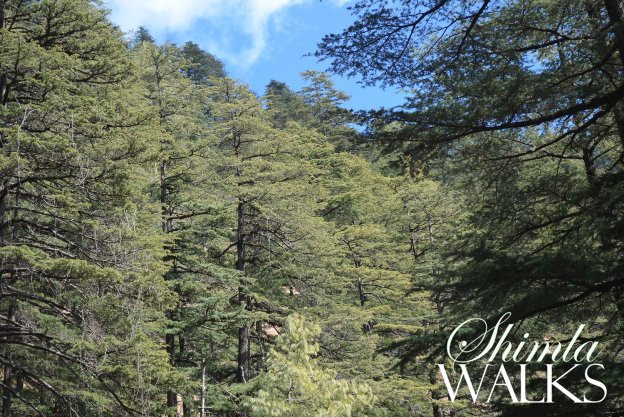You may choose to sit next to a brook or on a sunny glad, just close your eyes and leave yourself unattended. Just concentrate on your breathing and feel that you require nothing. The whole world is veiled for you. This is what you have been looking for and this is what you had always wanted. There is a lot of scope for photography in case you are carrying your camera, while walking through the dense forest of Shimla’s Catchment Area, the only reserved sanctuary around Shimla, you cannot hold it back. Silence accompanies you becomes your attire.
Catchment Area Shimla
Life, till now has been a race but here it stills. Famous as the Catchment Area Shimla, the sanctuary is located to the eastern exit of the town along the Hindustan Tibet Road. Spread in nearly 1000 hectares it starts right after Dhalli, a suburb of Shimla, and extends beyond Kufri. As you emerge from Dhalli Bazaar and choose to follow the road to your right, a large sized gate attracts your attention. This is the entrance gate to the sanctuary.
Entry Point to Catchment Area Shimla
Except Monday, the sanctuary remains open for the visitors only for three hours before lunch and 2 hours after lunch. It is strongly recommended that you carry sufficient drinking water and some eatables with you but please make sure that you bring all the rubbish back with you. A prior permission is required to enter the forest, from the Department of Wildlife. And at last, there are chances that the entry to the sanctuary is discontinued due to some managerial problems and that is also, without prior notice, so please check with the authorities before you plan your trip.
Wildlife in the Catchment Area Shimla Sanctuary
An encounter with a Ghoral, a Sambhar, a fox, a jackal, a flying squirrel or flying fox, a porcupine or may be a leopard like common here. You might also come across an Eagle following a Sterling or a house sparrow, a blue Magpie flies across your way or a jungle fowl flutters away listening to your footsteps.

Catchment Area Shimla
Pythons or snacks do not care for you as most of the snakes in the Himalayan countries are non-poisonous. It is recommended not to go alone. Carrying a weapon is not allowed and if you carry you will be stopped at the gate.
Here it is practically a coniferous forest that is dominated by Himalayan Cedar (Deodar), there also are some White Oak, Rebinia , Horse Chestnut, Monkey Chestnut, Blue Pine, different species of Oak such as Himalayan Oak and Mohru, Rhododendron, Spruce, and of course some ferns and high rising grass are found in abundance in Shimla Catchment Area.
Highlights Points of Catchment Area Shimla
Vehicles entry has been restricted to the sanctuary. You may choose to walk or hire a bicycle from the main gate. After seven kilometres a huge water reservoir built in 1901 by the British Government that measures 120 feet in length, 20 feet in breadth and 16 feet in depth, is located.
It has a capacity of 240,00,000 gallons of water and since then it has been supplying water to Shimla town. Next to the reservoir is a small hut of the Forest Ranger and one for the caretaker. Beyond this point you are allowed to walk on the same trail that continues for more seven kilometres and ends at a small shrine and a ruined hut.
Nearly twenty years ago this hut was hit by a fallen tree and after that the Department of Forest never thought of making it again. The roofless walls of this hut have been waiting for someone to come and make some efforts to bring them to the real shape but their hope are shattered after every visit of every Forest Officer. The old pipes of its Chimneys, from whom, once the smoke emerged, cry for help and the walls built in ‘dhajji’ style look like a leftover of some wild animal’s kill.

Stay inside the Sanctuary
But a Forest Rest House, surrounded by towering cedars and spruces trees just in the middle of the trail is anyone’s dream cottage. Before you reach the water reservoir a forest and a shady road bifurcates to left and ascends for a kilometre to the building of Forest Rest House. You will not find any space to turn your car until you have reached here. The Rest House is available only for two hours during the day as night stay in the sanctuary is not allowed.
So in case you plan to make it your home for some hours then ask the caretaker at the gate while purchasing the entry ticket to the sanctuary. Shimla is still known for the density of its forests around and enjoys the level of having the thickest forest in Asia. Shimla Catchment area plays a vital role in controlling the ecosystem of the area and also opens a new gate for the nature lovers.
The Hindustan Tibet Road runs along the sanctuary and it is said to see many Indian tourists throwing all sorts of rubbish down the hill, towards the sanctuary, that spoils the beauty of this lovely forest. It is suggested to have a control on this habit, understand your responsibility and help in maintaining the ecology.
Shimla Walks conducts Nature Walks covering all major locations in & around Shimla and makes you to have phenomenal experience. To go for a nature walk while having the best experience of being with nature visit following exclusive Nature Walks
Keep Walking & Enjoy with Nature.



This is truly useful, thanks.
This is really useful, thanks.
Thanks for the great guide